History of the Radio Receiver
History of the development of the radio or wireless radio receiver from the earliest antique radio sets using coherers, magnetic detectors, crystal radio sets, vintage radios using valves / tubes to modern high performance semiconductor based radios using digital signal processing and software defined radio techniques.
Radio Receiver History Includes:
Radio history / timeline
Radio receiver history
Superhet radio history
Classic vintage radio receivers
Radio technology is an integral part of everyday life. Everything from broadcast radio and television through to mobile phones, wireless connectivity, Internet of Things and much more are based around radio technology.
The history of the radio receiver is an integral part of the development of today's radio technology, and it is a fascinating story to see how we arrived at where we are today.

In 1895 Marconi demonstrated his first viable radio system, now more than a 100 years later the radios that are in use today bear no resemblance to the early equipment that was used.
The equipment that was used in the 19th Century was crude and very insensitive, nowadays receivers are very sensitive and they offer many facilities.
Radio technology developed through the age of the crystal radio set, early vintage and antique radios using valves / vacuum tubes to more advanced ones, and then the ae of the transistor dawned.
Modern radios are also used in a wide variety of applications from broadcast reception, through cellular telecommunications to satellite links and much more. To be able to operate in all these diverse areas, receiver technology has changed beyond all recognition.
These developments represent the work of many people from the earliest days of antique radios and vintage radios right up to the modern day. Some of these people have their names entered the technology history books, but the majority were just ordinary engineers or radio enthusiasts who remain unknown.
History of the radio - beginnings
The story behind the history of the radio begins with the discovery of radio waves themselves. A brilliant Scot named Maxwell was the first person to prove electromagnetic waves existed. However he only showed this mathematically and he was never able to demonstrate them in a practical form.
Although many people stumbled across them and demonstrated effects that now we know were radio waves, it was a German named Heinrich Hertz who knowingly demonstrated these new waves which Maxwell had proved existed. He used some spark gap equipment to transmit and receive radio or Hertzian waves as they were first called.
Hertz used a number of variations of the basic equipment. Essentially the transmitter consisted of a circuit in which a spark was made to jump across a gap.
A second circuit with similar dimensions but with a smaller gap was placed within a metre or so of the first circuit. When a spark was made to jump across the gap in the transmitter circuit, a smaller but simultaneous spark would be seen to jump across the gap in the second.
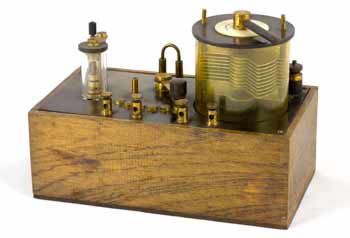
Naturally the range of this arrangement was very limited, mainly because the receiving circuit had to pick up a large amount of energy for the spark to jump across the gap.
Coherers
It was soon realised that more sophisticated and sensitive methods of detecting radio waves were needed. A device called a coherer became the basis for reception, and remained in widespread use for about ten years.
The coherer was based around the effect that had been known since the 1850s that small particles of dust or even metal filings stick together or cohere when an electric field is present.
The first person to use the phenomenon to detect radio waves was a Frenchman named Edouard Branly. He discovered that the resistance of a glass tube filled with metal filings fell from a few megohms to a few hundred ohms when placed close to a discharge. A short mechanical shock then restored the coherer to it high resistance state.
Once Branly had developed the basic idea, Oliver Lodge popularised it when he gave a lecture in 1898 in honour of Hertz who had recently died.. Lodge also made improvements to the device.
Usually the coherer was made to operate a bell so that when a spark or discharge took place the bell rang. A self-restoring feature was also introduced. The current flowing through the coherer was made to operate a small tapper that restored the coherer as well as ringing the bell. This meant at it was ready for the next discharge almost immediately.
Guglielmo Marconi
It was possibly Marconi who did more for the new technology of radio than any other person, especially in its early days. He believed that these new waves could be used to communicate over great distances. He also undertook many experiments and steadily improved the distances over which signals could be detected. He looked at the coherer and had his assistant spend many hours experiment with different materials to find the best combinations, and in this way he made some significant improvements.
As an indication of the way in which his developments were progressing he managed to span the Bristol Channel, and later he managed to send a message across the English Channel. During this experiment the signals were picked up at his factory in Chelmsford. This was considerably further than anyone had expected the signals could travel, and it made Marconi think that it would be possible to span the Atlantic.
Although Marconi's company did not have the funds to support a venture of this size, undeterred he set about the task, building stations in Britain and America and after many difficulties he managed to make contact in December 1901. This was an enormous achievement and it made headlines in the newspapers, but the sensitivity of the receiver proved to be the limiting factor. This set Ambrose Fleming, professor at University College London and consultant to Marconi thinking about the ways in which improvements could be made.
Magnetic detector
While the coherer was one of the first radio wave detectors, it had many limitations. Another form of detector that came into use was the magnetic detector, often known as the Maggie for obvious reasons.
The magnetic detector took over from the coherer, especially on maritime installations. It was also used by Marconi for his famous transatlantic transmission in 1901.
It had the advantage that it was possible to directly hear the detected incoming signals. With the coherer any signals were only indirectly heard.
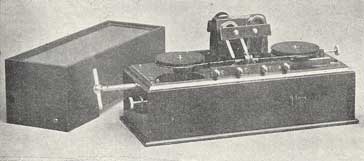
Fleming's Valve
The idea for this next development in receiver technology found its origins with Edison in America. He had been investigating the reasons for the short life of light bulbs. After a short while the inside of the bulbs became blackened and he could not find a way to prevent this.
It was thought that carbon from the filament was coating the inside of the glass. In one experiment to overcome the problem he placed a second wire or electrode into the bulb and noticed that current would flow between the electrodes if the negative end of a battery was connected to the heater filament and the positive end to the additional electrode.
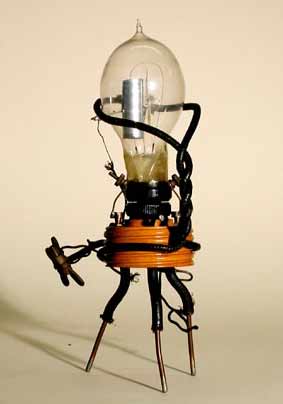
Marconi plc - with permission
He also noticed if the battery was reversed, then no current flowed.
Surprisingly, Edison could not find a use for this interesting phenomenon. Fleming who had seen the effect demonstrated by Edison wondered if it could be used to detect radio waves. He set his assistant to set up an experiment to discover if it could be used, and to their delight it did. He called it his oscillation valve because it acted in the same way as water valve in only allowing flow in one direction.
Crystal detectors
While Fleming's valve was a great stride forward it would take some years before thermionic technology was fully adopted. One of the reasons for this is that it was expensive to manufacture and to run. It could only be powered by batteries when used as a radio detector and batteries did not last for long because of the power required by the filament. Batteries were also very expensive as they had not been developed as much as they have been today.
Around this time work on other types of detectors started to be undertaken and it resulted in what was later known as the cat's whisker. It consisted of a crystal of a material such as galena with a small springy piece of wire brought up against it. The detector was constructed to that the wire contact could be moved to different points on the crystal, and thereby obtain the best point for rectifying the signal and the best detection.
These detectors soon gained the name Cat's Whiskers as a result of their construction. They were never very reliable and the whisker needed to be moved periodically to enable it to detect the signal properly. However they were very much cheaper than valves and gained widespread acceptance.
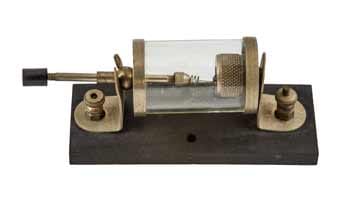
It is interesting to note that the Cat's Whisker was the first semiconductor device to be used. The materials that were used were semiconductors, and Cat's Whisker formed a very crude point contact diode.
Crystal radio sets became the radio of choice in the 1920s for broadcast listening. These crystal radio sets were produced by a huge number of companies and a new industry built up around them.
Triodes
Despite the success of the cat's whisker, work did not stop on the development of thermionic technology. An American named Lee de Forest was a competitor to Marconi and needed to develop receiver technology that did not infringe any patents to which Marconi had access.
To achieve this he devoted a large amount of time in developing a thermionic detector which did not infringe Fleming's patents. He took out a number of patents in the period between 1905 and 1907 covering a variety of developments that culminated in the form of the triode valve in which there was a third electrode called a grid. He called this tube an Audion.
With the benefit of hindsight it seems amazing that the Audion was initially used as a leaky grid detector and it took until 1911 for it to be used as an amplifier. Once this fact had been discovered many people were quick to exploit this fact in a variety of applications.
One of the first areas in which valves were used was in the manufacture of telephone repeaters, and although the performance was poor, they gave significant improvement in long distance telephone circuits.
With the discovery that triode valves could amplify signals it was soon noticed that they would also oscillate. This was a mixed blessing. It was a great disadvantage because these early valves were very difficult to stabilise when used for signals above a few kilohertz.
However the fact that valves could be used as oscillators was exploited in generating signals. Previously high frequency signals had been difficult to generate. If steady signals were required, electromechanical techniques had to be used, and these had obvious frequency limitations. With the use of valves it was possible to make relatively compact electronic oscillators.
TRF Receivers
Once the triode was established as an amplifier it made a tremendous difference to radio receiver performance as it allowed the incoming signals to be amplified. Previously most sets used crystal detectors and even with a large aerial, the signal levels were low.
The introduction of the triode valve enabled signals to be amplified so that more distant or weaker stations could be heard. However in virtually all cases the valve was used as an audio amplifier because of the stability problems with these early devices.
To be able to achieve sufficient gain, more than one valve was needed, and as their cost was very high, people looked at making the most efficient use of them. One way that proved very successful was introduced in 1913 and involved the use of positive feedback in the form of a regenerative detector. This gave significant improvements in the levels of gain that could be achieved.
These regenerative receivers proved to be very successful. The amount of feedback could be adjusted to the point of oscillation, and this greatly increased the gain and selectivity, enabling this type of receiver to out-perform all other forms.
1st World War developments
With the outbreak of the First World War, there was a great impetus to develop wireless technology further. Both sides of the conflict recognised the benefits it could bring, both in terms of improved communication and intelligence. One of the first areas on which development activity was focused was the valve itself. In these early days of thermionic technology their performance was poor. They lacked gain, especially at high frequencies and they were prone to oscillate when they were used at frequencies anything above a few kilohertz.
Originally it was thought that small amount of gas in the envelope was key to their operation. However an American named Langmuir disproved this and as a result a new generation totally evacuated "hard" valves were introduced. Not only was the operation of valves improved by the complete evacuation, but it also allowed the heaters to have coatings applied to them to improve their emission. In the old "soft" valves the gasses in the envelope contaminated the coatings making them unusable.
The other problem with valves was their susceptibility to oscillation. One of the main reasons for this was the level of capacitance between the grid and anode. A number of attempts were made to reduce this. H.J. Round undertook some work on this and in 1916 he produced a number valves with the grid connection taken out of the top of the envelope away from the anode connection. This proved to give a major improvement, but the final solution did not come until the 1920s.
Although the TRF receiver represented a major improvement in performance over what had been available before, it still fell short of the needs for some of the new applications. To enable receiver technology to meet the needs placed upon it a number of new ideas started to surface.
One of these was a new form of direct conversion receiver. Here an internal or local oscillator was used to beat with the incoming signal to produce and audible signal that could be amplified by an audio amplifier. Although the basic principle of the direct conversion had been known about for many years many considered the system was wasteful of valves because the oscillator and mixer did not contribute to the gain of the set. Even in military circles this was a consideration because of the size and cost of the valves and their associated batteries.
The problem was solved by one of Britain's leading wireless engineers, a man named H J Round. He developed a receiver he called an autodyne in which the same valve was used as a mixer and an oscillator, Whilst the set used fewer valves it was difficult to optimise the circuit for both the mixer and oscillator functions. To make the next leap forward in receiver technology a new type of set was needed.
Superhet radio
With the rise in use of wireless technology in a variety of areas, the need for greater selectivity became more apparent.
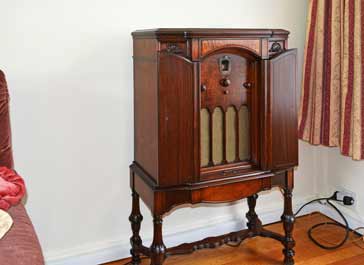
Crystal sets had neither the gain nor the selectivity needed, and also the new tuned radio frequency, TRF sets lacked the levels of selectivity required, especially as the number of transmitting stations rose and there was a need for greater levels of performance.
To combat this, the superheterodyne radio or to give it its shorter name the superhet radio rose in popularity, especially as the number of broadcast stations rose.
Once the use of the superhet radio was established it became virtually the only form or topology of radio that was used.
Various forms were developed including double and even triple superhet radios and they had correspondingly high levels of performance.
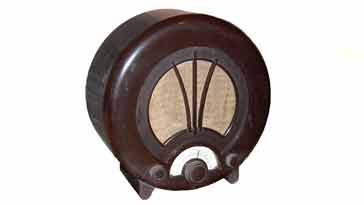
The need for the increased performance of the superhet was first felt in America and by the late 1920s most sets were superhets. However in Europe the number of broadcast stations did not start to rise as rapidly until later. Even so by the mid 1930s virtually all sets in Europe as well were using the superhet principle.
Transistor radio history
In the late 1940s the transistor was discovered. Initially the devices were not widely used because of their expense, and the fact that valves were being made smaller, and performed better. However by the early 1960s portable transistor broadcast radios were hitting the market place. These radios were ideal for broadcast reception on the long and medium wave bands.
They were much smaller than their valve equivalents, they were portable and could be powered from batteries. Although some valve portable receivers were available, batteries for these were expensive and did not last for long. The power requirements for transistor radios were very much less, resulting in batteries lasting for much longer and being considerably cheaper.
Although transistors gained a wide level of acceptance for broadcast sets, their introduction was a little slower in the professional market. The performance of the early transistors was much lower than that of valves, and this meant that high performance sets were not so easy to design.
Nevertheless as transistor performance improved and field effect transistors were introduced, semiconductor technology soon started to overtake that of valves. This was particularly true of the size and weight characteristics.
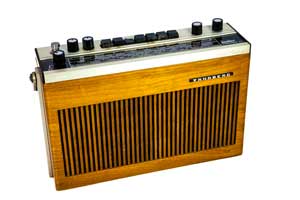
Further developments in semiconductor technology lead to the introduction of the integrated circuit. This enabled radio receiver technology to move forwards even further. The fact that integrated circuits enabled high performance circuits to be built for less cost, and significant amounts of space could be saved both gave advantages.
As a result of these developments new techniques could be introduced. One of these was the frequency synthesizer that was used to generate the local oscillator signal for the receiver. By using a synthesizer it was possible to generate a very accurate and stable local oscillator signal. Also the ability of synthesizers to be controlled by microprocessors meant that many new facilities could be introduced apart from the significant performance improvements offered by synthesizers.
21st Century
Receiver technology is till moving forward. Digital signal processing where many of the functions performed by an analogue intermediate frequency stage can be performed digitally by converting the signal to a digital stream that is manipulated mathematically is now widespread. Indeed the new digital audio broadcasting standard being introduced can only be used when the receiver can manipulate the signal digitally.
Whilst today's radios are miracles of modern technology, filled with low power high performance integrated circuits crammed into the smallest spaces, the basic principle of the radio is usually the superhet, the same idea which was developed by Edwin Armstrong back in 1918.
 Written by Ian Poole .
Written by Ian Poole .
Experienced electronics engineer and author.
More History:
Radio history timeline
History of the radio
Ham radio history
Coherer
Crystal radio
Magnetic detector
Spark transmitter
Morse telegraph
Valve / tube history
PN junction diode invention
Transistor
Integrated circuit
Quartz crystals
Classic radios
Mobile telecoms history
Vintage mobile phones
Return to History menu . . .



